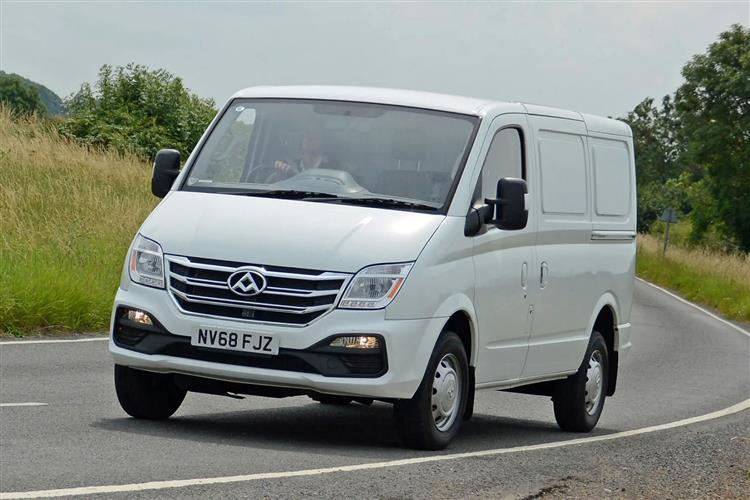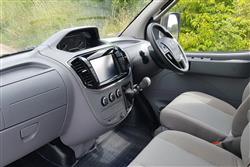BACK TO THE '80'S (some text hidden) --NONE--
By Jonathan Crouch
Introductionword count: 96
Van brand LDV returned to the commercial vehicle market in 2016 with this large-segment V80 model. True, it doesn't have the sophistication of the volume players in the large van sector from the 2016-2020 period, but it wouldn't do because it costs a fraction of what those vans are priced at. Despite the fact that it will probably serve most of the needs of your business just as well. In short, if you need profit more than polish when it comes to the purchase of a large used van, this contender could be worth a try.
Modelsword count: 6
Large van (2.5 diesel - 136hp)
Historyword count: 384
Today, perhaps more than ever, cost control is an over-riding priority in modern business and if you operate one, you'll be particularly conscious of it when it comes to purchasing the commercial vehicles upon which much of your company's livelihood may depend. If you deliver in bulk, you'll need a large van - or perhaps a small fleet of them. And if that's the case and you need to buy used, then the primary selling point of the contender we're going to look at here might be difficult to ignore, once you've been briefed about it. Welcome to the LDV V80, which sold here between 2016 and 2020. The V80's chief selling point doesn't really lie in any of the things that van makers usually talk about - technology, carriage capacity or engineering. No, let's get straight to it: this LCV is spectacularly affordable - as you'll discover if you start to check out prices on the used market. Which could translate into massive savings for your company if you were buying two or three large vans of this type. There are several reasons why LDV sold this model so cheaply. First, it needed to re-establish itself in the British market. The business that re-launched itself in 2016 was very different from the under-funded and rather shaky brand of the same name that eventually collapsed into receivership in 2009. By 2016, LDV was owned by Chinese manufacturing giant SAIC, the seventh largest vehicle maker in the world and the owner of MG. To kick things off for the new LDV era, the brand dusted off the old Maxus model it was selling a decade previously just before the receivers moved in. Which is what brought us the V80. Inevitably, the resulting package was a bit behind the current standard when it came to things like running cost efficiency, drive dynamics and media connectivity. Still, on the plus side, it backed up super-low up-front pricing with tough, practical virtues - and could even deliver a slice of modern technology in the form of an all-electric variant. The V80 sold until Spring 2020, when LDV was re-branded 'Maxus' and the V80 was replaced by the Maxus Deliver 9. So, does the V80 proposition make sense on the used market? That's what we're here to find out.
What You Getword count: 444
There's nothing much wrong with the way this V80 model looks: you certainly wouldn't immediately pigeonhole it as a dated design. The front end styling's clean and modern, with the short dual-creased bonnet flowing down into a chrome-finished front grille that shows off the LDV marque's corporate branding. Inside, the first thing you'll notice is that the instrument binnacle isn't where you'd expect to find it. Instead of being viewable through the four-spoke steering wheel, the two main dials have been positioned at the top of the silver-coloured centre stack. The seating placement is high and commanding and the vast windscreen gives a clear view ahead, plus there are large mirrors with manually-adjustable secondary mirrors below them. As usual with a large van, a three-person front bench is provided as standard. Three main panel van body styles were offered to LDV V80 buyers - short wheelbase 'low' roof, long wheelbase 'medium' roof and a long wheelbase 'high' roof. All based around a 3.5-tonne vehicle mass. So let's check out the practicality being delivered in a little more detail. As usual, two big rear doors open first out to 90-degrees, then can be pushed back to 270-degrees if you remove the stays and fold the doors round to magnetically click into place on large humps. The rear door opening width is 1,550mm, while the rear door opening height on the 'high' roof variant is 1,790mm, up from 1,580mm with the 'medium' roof body style. There's a low floor loading height and inside, you'll find decent load area lighting, nine tie-down points and an easy-clean non-slip cargo mat for the floor, though some original operators will have specified a proper ply-lining kit to protect the interior metal work. On the long wheelbase model, there's 3,300mm of cargo area length and 1,770mm of cargo area width, narrowing to 1,380mm between the wheel arches. The cargo area height is 1,925mm - up from 1,710mm with the 'medium' roof body style. That means a total cargo volume of 11.6m3 - up from 10.4m3 with the 'medium' roof body style. As a point of comparison, the entry-level short wheelbase 'low' roof model can only take 6.4m3. So yes, providing you go for the lengthiest wheelbase, most of what you'll want to take will probably fit. The payload figures aren't especially notable by class standards though. In the long wheelbase range, you're looking at 1,419kg for a 'medium' roof model and 1,389kg for a 'high' roof. If you're loading from the side, there's enough side door opening width (1,290mm) to be able to slot in a Euro pallet and whatever your roof choice, you get a 1,590mm side door height aperture.
To see the full road test text contact us on 0330 0020 227
Pictures (high res disabled)

.jpg)
|
.jpg)
|
.jpg)
| |||
.jpg)
|

|



